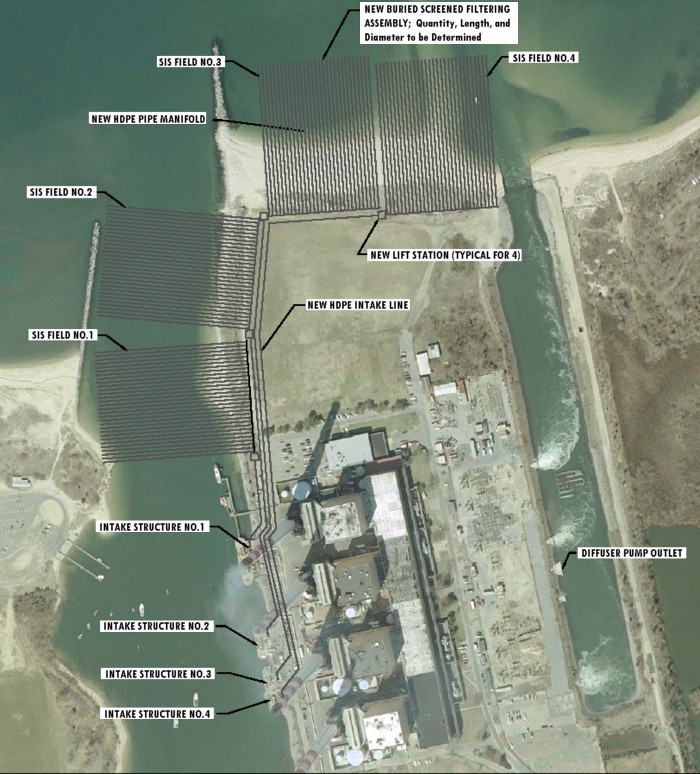 |

KEYSPAN GENERATION LLC
STUDIES THE SUBSTRATUM INTAKE SYSTEM (printer friendly version uses Acrobat Reader) |
||||||||
|
of EEA's Environmental Consulting Activities Spring 2005
e-mail addresses:
For information or quotes, Phase I ESAs
|
|
 |

KEYSPAN GENERATION LLC
STUDIES THE SUBSTRATUM INTAKE SYSTEM (printer friendly version uses Acrobat Reader) |
||||||||
|
of EEA's Environmental Consulting Activities Spring 2005
e-mail addresses:
For information or quotes, Phase I ESAs
|
|
|
|
Hydrogeology Investigation The first phase was to gather available subsurface geologic data from the power plant, from U.S. Geological Survey reports, bottom studies, including those involving sub-bottom borings, and offshore seismic studies. Available data were used to determine the presence of favorable water-bearing strata necessary to provide the huge volumes required at a typical power plant site. A key element of this subtask was to determine substrate water temperature as well as the seasonal temperature variations of the overlying surface waters presently utilized for cooling at the plant. |
||
|
|
Groundwater Modeling This subtask involved substrate groundwater modeling to predict the optimal depth of the intake screens. Groundwater modeling also gave invaluable information on how the water withdrawal would change the substrate aquifer characteristics and the expected replenishment time scenarios. The model also can be utilized to assist in the conceptual engineering layout, e.g., how far apart, vertically and horizontally, the well screens should be separated Conceptual Engineering and Cost Projections This investigation subtask involved conceptual level design engineering of substrate intake screen lengths and diameters, location of booster pumps, manifolds and similar features of the SIS concept. This subtask was conducted in consultation with site engineers to ensure that all SIS engineering recommendations are feasible from a utility and plant viewpoint.
Regulatory Agency Consultation If requested, a formal presentation of the SIS investigations and findings will be made to concerned regulators including the Regional and Federal representatives. Report and Recommendations for SIS Development The last subtask of the feasibility study was a detailed report with results and expected benefits of an SIS construction and operation. In addition, if all tasks are successfully implemented, a field investigation plan will be developed that would cover additional exploratory drilling, aquifer testing, and the information that would be necessary to design a working prototype horizontal well. This subtask will include preparation of the design specifications, bid documents, and deliverables needed to proceed with installation and testing of a prototype intake structure.Presently, Keyspan is reviewing the report and deciding on whether to undertake more detailed programs such as a pilot study and a demonstration project. For more information on the Substratum Intake System contact jmcaleer@eeaconsultants.com |
|
In September of 2004, EEA’s Dr. Roy Stoecker presented SIS to the New York State Department of Environmental Conservation Thermal Energy Task Force in Albany, NY and later that month to the Electric Power Research Institute (EPRI) Cooling Water Intake Technologies Conference in Worchester, MA. Both presentations were well received and generated considerable interest In February and March 2005, Dr. Stoecker presented the SIS concept to USEPA regional and subsequently headquarter officials in Washington concerned with cooling water issues. |
|
|||
|
Patent Status 25 Years of Service to Government and IndustryIn
August of 2004, EEA, Inc. (Energy & Environmental Analysts, Inc.) and the
founding principals, Leland Hairr, Ph.D., President, Roy
Stoecker, Ph.D., Vice President, and Allen Serper, P.E., Vice President,
celebrated 25 years as environmental consultants. EEA’s client list
includes many Fortune 500 companies, as well as state and municipal
agencies. A partial list is available at our site at
www.eeaconsultants.com |
 |
||
|
Aerial View of a Typical SIS Design |
|
Related EEA Newsletters: ENTRAINMENT and IMPINGEMENT? What's That? Power Plants and Cooling Water Intake Structures (CWIS) SUBSTRATUM INTAKE SYSTEM. An Innovative Water Intake System for Power Generation Facilities. Spring, 2004. |
05/03/05